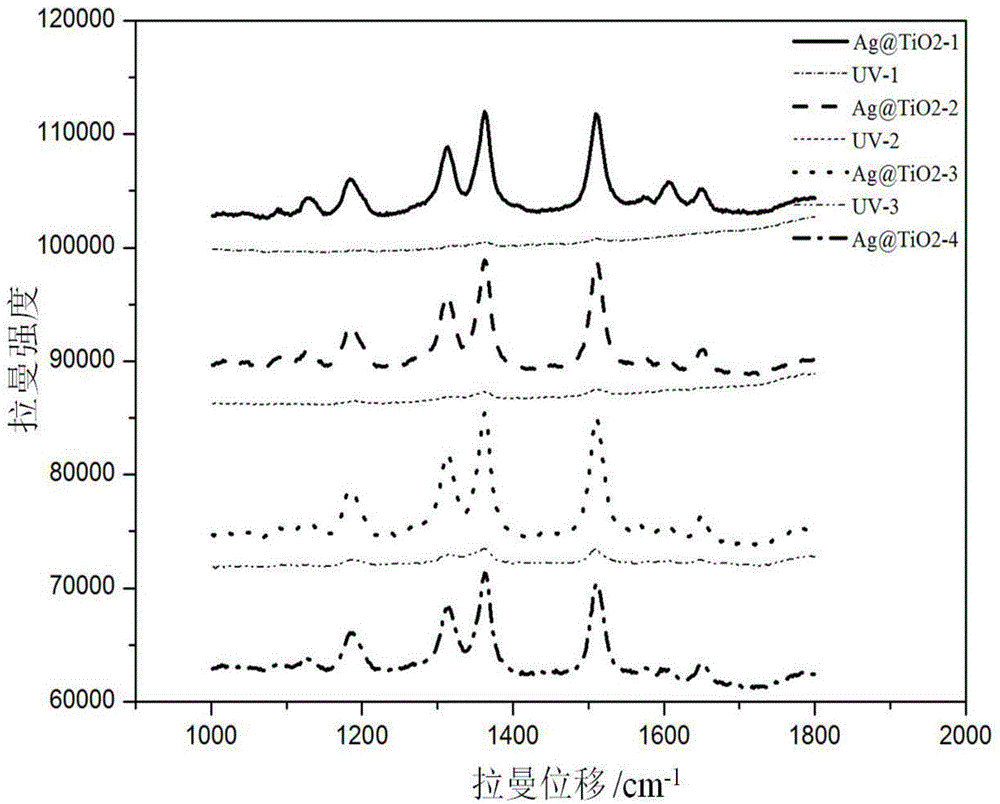High-stability recyclable surface-enhanced Raman substrate and preparation method
A surface-enhanced Raman, high-stability technology, used in Raman scattering, gaseous chemical plating, superimposed layer plating, etc. Chemical stability and other issues, to achieve excellent performance stability and recycling function, good surface enhanced Raman effect, anti-oxidation effect
- Summary
- Abstract
- Description
- Claims
- Application Information
AI Technical Summary
Problems solved by technology
Method used
Image
Examples
Embodiment 1
[0018] 1. Clean the silicon substrate or glass substrate sequentially with acetone, alcohol and deionized water and dry them;
[0019] 2. Fix the pretreated substrate on the sample stage of the electron beam evaporation coating machine;
[0020] 3. At room temperature, using metallic silver as the target material, pump the chamber of the electron beam evaporation coating machine to a vacuum degree of 3×10 -5 Pa;
[0021] 4. Adjust the incident angle of the electron beam to 82 degrees, and make the sample stage static, and grow a silver nanorod thin film with a nanorod length of 300nm obliquely on the substrate of the sample stage;
[0022] 5. By atomic layer deposition, a uniform and dense titanium oxide film is deposited on a silver substrate at 82°C to prepare a silver-titanium oxide composite film, wherein the thickness of the titanium oxide film is 1.5nm;
[0023] 6. Preparation 10 -6 mol / L rhodamine 6G solution;
[0024] 7. Put the surface-enhanced Raman substrate pre...
Embodiment 2
[0029] 1. Clean the silicon substrate or glass substrate sequentially with acetone, alcohol and deionized water and dry them;
[0030] 2. Fix the pretreated substrate on the sample stage of the electron beam evaporation coating machine;
[0031] 3. At room temperature, using metallic silver as the target material, pump the chamber of the electron beam evaporation coating machine to a vacuum degree of 5×10 -5 Pa;
[0032] 4. Adjust the incident angle of the electron beam to 85 degrees, and make the sample stage rotate at a rate of 5rpm, and grow a silver nanorod thin film with a nanorod length of 400nm on the substrate of the sample stage;
[0033] 5. By atomic layer deposition, a uniform and dense titanium oxide film is deposited on a silver substrate at 90°C to prepare a silver-titanium oxide composite film, wherein the thickness of the titanium oxide film is 2.3nm;
[0034] 6. Preparation 10 -6 mol / L rhodamine 6G solution;
[0035] 7. Put the surface-enhanced Raman subst...
Embodiment 3
[0040] 1. Clean the silicon wafer substrate or glass substrate sequentially with acetone, alcohol, and deionized water, and then dry it;
[0041] 2. Fix the pretreated substrate on the sample stage of the electron beam evaporation coating machine;
[0042] 3. At room temperature, using metallic silver as the target material, pump the chamber of the electron beam evaporation coating machine to a vacuum degree of 8×10 -5 Pa;
[0043] 4. Adjust the incident angle of the electron beam to 88 degrees, and make the sample stage rotate at a rate of 10rpm, and grow a silver nanorod thin film with a nanorod length of 500nm on the substrate of the sample stage;
[0044] 5. By atomic layer deposition, a uniform and dense titanium oxide film is deposited on a silver substrate at 100°C to prepare a silver-titanium oxide composite film, wherein the thickness of the titanium oxide film is 3.1nm;
[0045] 6. Preparation 10 -6 mol / L rhodamine 6G solution;
[0046] 7. Put the surface-enhance...
PUM
| Property | Measurement | Unit |
|---|---|---|
| Thickness | aaaaa | aaaaa |
| Wavelength | aaaaa | aaaaa |
| Thickness | aaaaa | aaaaa |
Abstract
Description
Claims
Application Information
 Login to View More
Login to View More - Generate Ideas
- Intellectual Property
- Life Sciences
- Materials
- Tech Scout
- Unparalleled Data Quality
- Higher Quality Content
- 60% Fewer Hallucinations
Browse by: Latest US Patents, China's latest patents, Technical Efficacy Thesaurus, Application Domain, Technology Topic, Popular Technical Reports.
© 2025 PatSnap. All rights reserved.Legal|Privacy policy|Modern Slavery Act Transparency Statement|Sitemap|About US| Contact US: help@patsnap.com



